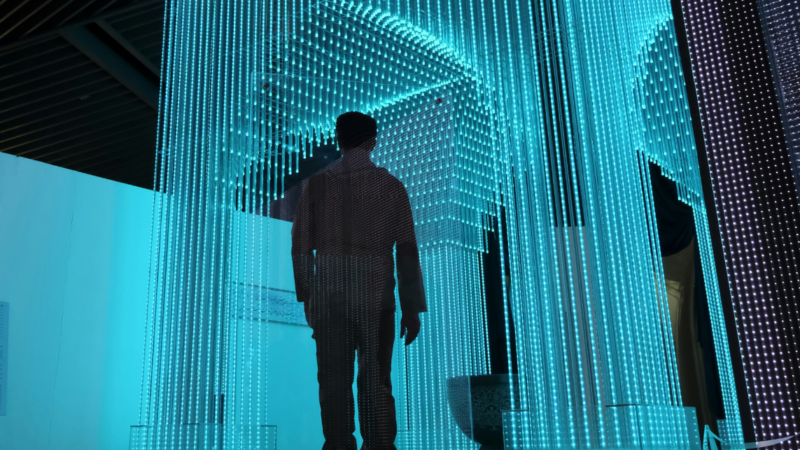Making sense of our connected world

Augmented and virtual reality applications that matter
In this second part of his series: startup and technology trends 2017, Robin Tech discusses augmented and virtual reality technologies. He touches upon applications in the fields of gaming, pornography, machine maintenance, shopping, and human-machine-interaction. Continue reading about the technological possibilities and developments that might make our lives better – and that will certainly shape our realities in future.
Augmented and virtual reality (AR & VR) devices have seen a year of broad media coverage – including an avalanche of videos showing people falling over because they forget that their bodies remain in the real world while their minds wander off to distant planets, skydiving adventures, or horror movies . There are multiple obvious applications that are also easy to implement. These low hanging fruits include gaming, pornography, and media consumption in general.
Last year, Pokemon Go took the world by storm by enabling ordinary smartphones to act as augmented reality devices, beaming little monsters onto your desk, lawn, or toilet bowl. The still bulky headsets required for virtual reality are much more intrusive and difficult to use. Headsets such as HTC’s Vive and Facebook’s Oculus Rift saw dropping sales volumes after a short-lived hype. Prices were dropped recently, and it remains to be seen if we indeed face a mass market application or rather a niche phenomenon. Startup investors – who are usually ahead of the curve – recently increased their spendings in this sector. In 2016, we saw 30% more venture capital deals and a 58% increase in deal size compared to the previous year (Dawson, 2017). I have no doubt that these numbers will be similar in 2017, as content production is still lagging behind and more and more possible applications are being tested by startups and large corporations alike.
What’s interesting is that applications that actually solve a problem are becoming more wide-spread. Rather than just notch up consumers’ level of convenience or entertainment, B2B focused AR and VR products can have a tremendous impact on industry processes. Startups such as Daqri build headsets that allow technicians to do maintenance work on complex machines without having in detail knowledge of it. Instead, computer programs and experts can remotely connect to the headset and instruct the worker. Another application is in the healthcare sector. AR/VR technology can help those who might not be able to visit certain places (anymore). But it can also alleviate trauma and shock by letting patients temporarily escape into virtual worlds. Companies like HappyMed work on devices that reduce stress during operations or recovery, though with a purely video-based solution so far. My suggestion is to look out for use cases that go beyond mere entertainment, and to think about processes that are done in a way that is not necessarily the best way. Think navigation when you cannot use your hands, think video conferences that are as immersive as actually being there, think online shopping that let’s you try on clothes or offline shopping with stores that only display what you are interested in, think education and teaching, think human-machine-interaction in general. Computer systems become increasingly complex to handle and interact with. This quite necessarily requires novel ways of interaction. I suspect that we will see a combination of various technologies ranging from speech recognition and natural language processing, augmented realities featuring lifelike avatars, and virtual realities that allow for an immersive and therefore highly efficient operation of machines. In short, AR and VR applications that will define the way we interact with technology in 2017 and beyond. Those applications that enable humans and that significantly reduce costs, because they help to overcome essential challenges will be the ones that pave the way for a wide-spread adoption of AR and VR technologies.
In my next blog posts, I’ll talk about smart homes that finally make sense and and how they are (sometimes) not so smart, gene analysis and editing technologies that raise much more than ethical questions, and space flight.
This post is part of a weekly series of articles by doctoral candidates of the Alexander von Humboldt Institute for Internet and Society. It does not necessarily represent the view of the Institute itself. For more information about the topics of these articles and associated research projects, please contact info@hiig.de.
Photo: CC0
This post represents the view of the author and does not necessarily represent the view of the institute itself. For more information about the topics of these articles and associated research projects, please contact info@hiig.de.

You will receive our latest blog articles once a month in a newsletter.
Digital future of the workplace
AI at the microphone: The voice of the future?
From synthesising voices and generating entire episodes, AI is transforming digital audio. Explore the opportunities and challenges of AI at the microphone.
Do Community Notes have a party preference?
This article explores whether Community Notes effectively combat disinformation or mirror political biases, analysing distribution and rating patterns.
How People Analytics can affect the perception of fairness in the workplace
People Analytics in the workplace can improve decisions but may also heighten feelings of unfairness, impacting employee trust and workplace relationships.




